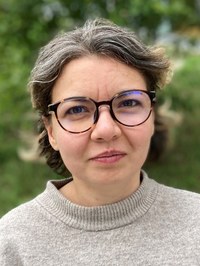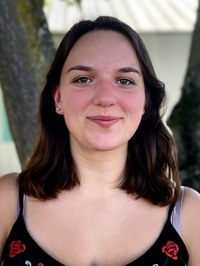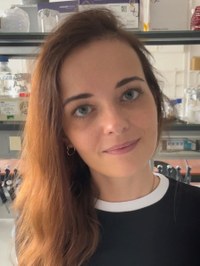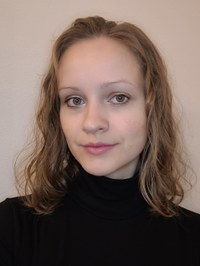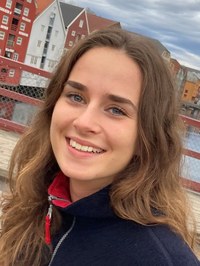Projects & People
Functional characterization of the antagonistic interactors Sub2 and Tho1 in nuclear mRNP biogenesis |
|||
|
Prof. Dr. Katja Sträßer
Principal Investigator
|
Daniel Bauer
Doctoral Candidate
|
Palina Kot
Doctoral Candidate
|
Nils Holger Maier
Doctoral Candidate
|
|
Protein synthesis in eukaryotes is a complex, multi-step process: First, the respective gene is transcribed into messenger RNA (mRNA). This mRNA is then processed (capped, spliced and polyadenylated) and packaged into a messenger ribonucleoprotein particle (mRNP) by nuclear mRNA-binding proteins to enable and regulate its export to the cytoplasm. Here, ribosomes use the mRNA to synthesize proteins. mRNP formation is thus a crucial step in eukaryotic gene expression. In this project, we study the function of two protein, Sub2 and Tho1, in nuclear mRNP assembly and connected processes in the model organism S. cerevisiae. Link AG Sträßer |
|||
Molecular mechanism of Sub2 and Tho1 in nuclear mRNP biogenesis and RNA:DNA hybrid prevention |
||
|
Apl. Prof. Dr. Peter Friedhoff
Principal Investigator
|
Fabienne Becker
Doctoral Candidate
|
|
|
In the field of eukaryotic gene expression, the export of mRNA from the nucleus is an essential step. The TREX complex (consisting of the THO complex, the RNA helicase Sub2 (human UAP56), Tho1 (human CIP29) and other proteins) plays a critical role in this process. The goal of this project is to investigate the physical and functional interaction between Sub2 and Tho1 in mRNP formation and RNA:DNA hybrid resolution. Our team will use a combined approach of mutational analysis, crosslinking, MS and in vitro RNA-protein crosslinking to determine the interaction surface and nucleic acid interaction between the two proteins from the model organisms Saccharomyces cerevisiae and Schizosaccharomyces pombe, among others. Link AG Friedhoff |
||
Molecular characterization of the impact of DEAD box helicase-dependent structural RNA remodelling on a regulated intron retention event |
|||
|
Dr. Cornelia Kilchert
Principal Investigator
|
Jacqueline Böhme
Doctoral Candidate
|
Ebru Aydin
Doctoral Candidate
|
 Jan Weber
Doctoral Candidate
|
|
Across kingdoms, DEAD box ATPases are involved in multiple aspects of RNA metabolism, including RNA maturation and decay, regulation of translation, RNA granule homeostasis, and the modulation of non-coding RNA activity. At the molecular level, they act as RNA remodelling helicases, and their various biological functions are thought to depend on their ability to rearrange structural RNA elements and remodel entire mRNPs through RNA unwinding and annealing activities. However, these remodelling events have rarely been characterised. Dead box protein 2 (Dbp2) of fission yeast is a conserved, essential member of the family that is recruited to transcribing RNA polymerase II and, among other things, regulates splicing of the second intron in its own pre-mRNA to control protein expression in an instance of autoregulatory feedback control. This suggests that RNA helicase-mediated RNA structure remodelling can act as an on/off switch that governs RNA processing decisions. In this project, we study Dbp2-dependent regulation of the retention of intron 2 as a model to understand the interconnections between RNA structure remodelling, altered RNA-protein interaction, and changes in RNA processing outcome in molecular detail. Link AG Kilchert |
|||
Analysis of interactions of viral proteins with cellular RNAs - how RNA viruses alter RNA networks |
||
|
Dr. Oliver Rossbach
Principal Investigator
|
Sophie Stebel
Doctoral Candidate
|
Yannic Noe
Doctoral Candidate
|
|
The molecular interactions between viral proteins and components inside of host cell are an important and yet understudied field in RNA virology. The aim of our project is to systematically analyze the influence of RNA virus infection on the cellular mRNA life cycle across various virus families, and to identify interaction surfaces where therapeutic RNAs can interfere. We will first identify viral proteins that directly bind to RNAs and characterize their cellular RNA interaction partners using biochemical in vivo binding studies and sequencing (CLIP; UV-crosslinking and immunoprecipitation). Second, we will monitor changes in cellular mRNA processing and turnover induced by viral protein binding during infection, and third, we will develop and produce circRNA decoys that can interfere with these interactions, aimed at inhibiting crucial steps in the viral replication cycle. Research will focus on alpha- and beta-coronaviruses such as HCoV-229E and SARS-CoV-2 (positive-strand RNA viruses); and the Rift Valley Fever Virus (RVFV; a negative-strand Phlebovirus). Link AG Rossbach |
||
Antibiotic-dependent and -independent functions of the trp attenuator-derived sRNA rnTrpL in Escherichia coli |
||
|
Apl. Prof. Dr. Elena Evguenieva-Hackenberg
Principal Investigator
|
Jennifer Kothe
Doctoral Candidate
|
Theresa Dietz
Doctoral Candidate
|
|
Gene expression change after exposure of bacteria to antibiotics is the basis for their successful adaptation to the antibiotic stress. However, the early events of this adaptation are still unexplored. Gene regulation at the level of RNA and by RNA-regulators is known for very fast adaptive responses. We are analyzing the RNA-based mechanisms of the bacterial response after short-time exposure to antibiotics in the model organisms of Sinorhizobium meliloti and Escherichia coli. Link AG Evguenieva-Hackenberg |
||
Scalable, reproducible and FAIR bioinformatics workflows for automated analysis of multi-dimensional RNA-based viral sequence data |
|||
|
Prof. Dr. Alexander Goesmann
Principal Investigator
|
Dr. Jochen Blom
Associated Principal Investigator
|
Fabienne Thelen
Doctoral Candidate
|
Patrick Barth
Doctoral Candidate
|
|
Standardized and automated data processing is a crucial prerequisite to achieve valid, comparable and reproducible results in all kinds of RNA-related experiments. To support this task, we develop tailored analysis workflows based on the needs of and in close cooperation with the partners in the RTG2355. Besides the analysis of RNA data, a further focus of our workflow development is the analysis, evaluation and visualization of multi-dimensional viral datasets. Newly developed bioinformatics workflows will be integrated into the open data management platform openBIS, furthermore a workflow repository will be created in close collaboration with the National Research Data Infrastructures (NFDIs) to ensure compliance with the standards developed in these consortia. Data management will be developed in compliance with the FAIR principles, i.e., experimental data and analysis results are findable, accessible, interoperable, and reusable. Link AG Goesmann |
|||
Controlling the switch from viral RNA genome translation to genome replication: the moonlighting function of cellular Glycyl-tRNA synthetase during picornavirus infection |
||
|
Apl. Prof. Dr. Michael Niepmann
Principal Investigator
|
Fabian Dross
Doctoral Candidate
|
Jessica Fedrau
Doctoral Candidate
|
|
Picornaviruses evolved secondary structures in their genomic RNAs that bind proteins of the host cell and use them in so-called "moonlighting" functions to facilitate translation of their own genome. A tRNA anticodon stem-loop-like structure in the 3´UTR of Mengovirus genomic RNA specifically binds to the cellular enzyme Glycyl-tRNA synthetase (GARS). Translation of the Mengovirus full length genome in cells is impaired by mutation of this GARS binding element (GBE) directly after transfection, independent of the activity of the viral polymerase. Also, translation of short artificial reporter RNAs containing the Mengovirus untranslated regions is impaired by mutation of the GBE. Thus, the GBE is involved in Mengovirus translation regulation. We aim to further characterize the interaction of this GARS binding element with the cellular translation machinery and its impact on the viral replication cycle. Link AG Niepmann |
||
Viral and cellular regulators of the mRNA translation inhibitor PKR
|
|||
|
Prof. Dr. Friedemann Weber
Principal Investigator
|
Dr. Lyudmila Shalamova
Principal Investigator
|
Kiriaki Kouti
Doctoral Candidate
|
Kai Wallerang
Doctoral Candidate
|
|
PKR is an interferon-induced protein kinase commonly activated by double-stranded RNA from pathogens such as replicating RNA viruses. Additionally, cellular RNAs can interact with PKR in an activating or inhibiting manner. Our group focusses on determinants of PKR activation from both positive- and negative-sense RNA viruses: SARS-CoV-2 and RVFV, respectively. Probing RNA-protein and RNA-RNA interactions with various techniques, we aim to identify not only RNA species of viral or cellular origin that interact with PKR, but also to reveal RNA structure prerequisites for these interactions. Link AG Weber
|
|||
Structural and functional characterization of two putative cis-acting RNA elements in the 3'-untranslated regions of coronavirus genomes |
|||
|
Prof. Dr. John Ziebuhr
Principal Investigator
|
Dr. Ramakanth Madhugiri
Associated Principal Investigator
|
 Jorina Eckersberg
Doctoral Candidate
|
Mohamed Darwish
Doctoral Candidate
|
|
Replication and transcription of coronavirus genomes are mediated by the so-called replication-transcription complex (RTC) comprised of more than a dozen proteins. However, several specific cis-acting RNA structural and sequence elements located in the terminal regions of the viral genomic RNA are also thought to be involved. Some of these RNA elements were suggested to be conserved among alpha- and beta-coronaviruses, indicating important roles in viral replication. We study the biological functions of two of these conserved RNA elements and their interactions with components of the RTC and with host cell proteins using a combination of coronavirus reverse genetics, proteomics, and RNA biochemistry approaches (e.g., RNA structure probing, RNA-protein interactions using RNA-Map and reporter gene assays). Link AG Ziebuhr |
|||
Regulation of bacterial transcription by 6S RNAs
|
||
|
Prof. Dr. Roland Hartmann
Principal Investigator
|
Ahmad Altoun
Doctoral Candidate
|
Luis Bellof
Doctoral Candidate
|
|
Non-coding 6S RNAs regulate transcription by binding to the active site of specific bacterial RNA polymerase (RNAP) holoenzymes. RNAP can reverse this inhibition by utilizing 6S RNA as a template for the synthesis of short transcripts that remain bound to 6S RNA and rearrange its structure, leading to dissociation of 6S RNA from RNAP. Bacillus subtilis expresses two 6S RNA paralogs whose gene knockouts lead to very different and rather specific phenotypes in a wild-type strain (NCIB 3610): The ∆6S-1 RNA strain grows to lower optical density during extended stationary phase, while the ∆6S-2 RNA strain shows derepressed biofilm formation, retarded swarming activity and accelerated spore formation. The ∆6S-1&2 double deletion strain displays prolonged lag phases of growth under oxidative, high salt and alkaline stress conditions, in addition to decelerated spore formation. We aim to understand the causes of these phenotypes on the molecular and moleculargenetic level by applying biochemical, genetic and global analysis (transcriptomics, proteomics, ChIP-seq) methodologies. Link AG Hartmann |
||
Epitranscriptomic analysis of the RNA stability in Escherichia coli during T4 phage infection |
||
|
Dr. Katharina Höfer
Principal Investigator
|
Helene Keuthen
Doctoral Candidate
|
|
|
Since dynamic regulation of RNA stability during T4 phage infection of E. coli has been identified for both host and phage transcripts, our project aims to determine and characterize the molecular mechanisms that regulate RNA stability during the infection process. For this purpose, we will first investigate the functional role of nucleases and RNA-binding proteins on RNA stability and processing during phage infection. Second, we will apply our NAD captureSeq approach to analyze the presence and function of E. coli and T4 NAD-capped RNA during infection, and third, we will focus on the interaction of RNA-binding proteins with small regulatory RNAs (sRNAs) present in E. coli and in T4 phages by performing cross-linking (iCLIP) experiments. This study will broaden our understanding of how T4 and E. coli nucleases and RNA binding proteins orchestrate RNA stability during infection and how RNA modifications modulate RNA stability to trigger an effective T4 infection. Moreover, these biological insights may provide new knowledge for applications in biotechnology and medicine. Link AG Höfer |
||
Molecular analysis of in vivo functions of lncRNAs in mammalian contractile tissues |
||
|
Apl. Prof. Dr. Thomas Böttger
Principal Investigator
|
Sara Hettrich
Doctoral Candidate
|
|
|
We are specifically interested in a long non-coding RNA (lncRNA) that regulates differential splicing of a messenger RNA in striated muscle; malfunction of this lncRNA appears to be connected to cardiac hypertrophy. The aims of this project are therefore to identify, first, elements of the lncRNA that are essential for the regulation of alternative splicing, and second, proteins that might interact with the lncRNA and control its function. Third, we are interested in the consequences of the alternative splicing on the molecular as well as the physiological level. Link AG Böttger |
||
Role of alternative splicing and circRNA function in adipogenesis, glucose homeostasis, and obesity |
||
|
Dr. André Schneider
Principal Investigator
|
Maximilian Staps
Doctoral Candidate
|
|
|
Post-transcriptional regulation of gene expression encompasses multiple processes including splicing, modification, editing, translation, transport, storage and turnover of RNAs. Our overall goal is to decipher the functional role of RNA binding proteins in regulating alternative splicing of linear mRNAs and circRNAs in adipogenesis, obesity as well as in cardiovascular diseases. Furthermore, we are investigating m6A modifications in the context of disease processes of the myocardium. Combining transgenic as well as viral-mediated gain- and loss-of-function approaches in vivo with cell culture systems, we are aiming to decipher and manipulate novel disease-relevant molecular pathways. Link AG Schneider |
||
Deconstructing context-dependent regulatory miRNA networks in T cell development |
||
|
Prof. Dr. Andreas Krueger
Principal Investigator
|
Hanna Steede
Doctoral Candidate
|
|
|
Human health depends on the continuous generation of fresh immune cells, and a thorough understanding of the underlying molecular and cellular mechanisms is of great importance for improving treatment of many diseases. In this context, our laboratory investigates how post-transcriptional gene regulation and, more specifically, certain microRNAs (miRNAs) contribute to the formation of a functional yet non-autoreactive pool of peripheral T cells. miRNAs are key mediators of post-transcriptional gene regulation, serving as guides inducing degradation or translational inhibition of target mRNAs, and we aim to unravel how structural features of the mRNA targets, target site occupancy by RNA-binding proteins as well as competition and/or cooperativity between miRNAs contribute to miRNA function. Link AG Krueger |
||
Algorithmic design of RNA secondary structure prediction tools |
||
|
Prof. Dr. Stefan Janssen
Principal Investigator
|
|
|
|
RNA is not a linear molecule, but folds onto itself by forming base pairs between nucleotides of the same strand, often establishing long-range interactions within the respective molecule. This so-called secondary structure significantly contributes to gene regulation, e.g., by changing accessibility of ribosome binding sites, other protein or RNA binding sites. We will make use of the experimentally derived structure probing data generated by various RTG groups to improve RNA secondary structure prediction tools, generating algorithms that suggest several possible secondary structures instead of only a single structural model. Link AG Janssen |
||
Affiliated Postdocs |
|||
|
Dr. Nadine Wäber
(AG Kilchert)
|
Dr. Shan Lin
(AG Schneider)
|
Dr. Johanna Seidler
(AG Sträßer)
|
|



